*We spotted the ocean At the head of the trail Where are we goin' So far away And somebody told me That this is the place Where everything's better And everything's safe *
- Walk on the ocean... Thanks Toad the Wet Sprocket*
**
4 Wheelers from Tundra to Tropics!
I bet Paulo didn’t realize I really did need that ATV training for more than the tundra! Speaking of which I still want my special certificate!
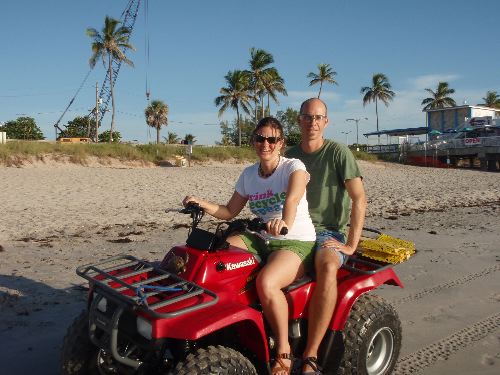 Riding on our Atlantic Ocean beach brings memories of riding on the beaches of the Arctic Ocean
Riding on our Atlantic Ocean beach brings memories of riding on the beaches of the Arctic Ocean
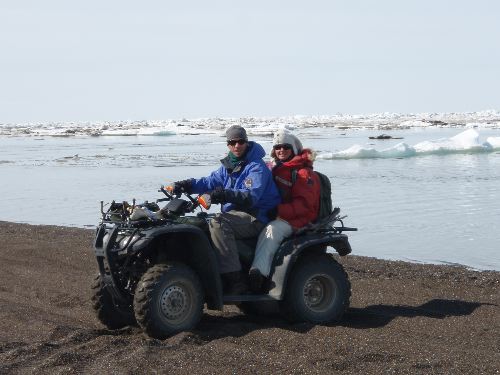 The very tip top of North American soil! Point Barrow Proper. Photo by Hiroki Ikawa
The very tip top of North American soil! Point Barrow Proper. Photo by Hiroki Ikawa
What a** contrast,** just weeks ago I was riding an ATV around Point Barrow with Rob, the Nuvuk team looking for bones and Hiroki showing us his project! The sand was gray and course, the wind was cool, the Arctic Ocean had ice blowing **around, the beach wore **whalebones, driftwood and around Point Barrow the trash was minimal to none.
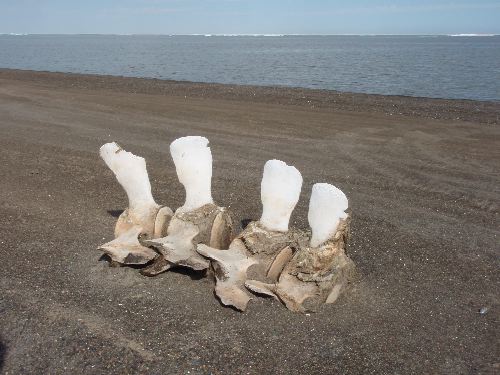 It's all natural and beautiful art! What do you think? Whale vertebrae or a super sized seal?
It's all natural and beautiful art! What do you think? Whale vertebrae or a super sized seal?
Our beach is on the Atlantic Ocean. The sand is white and very fine. The beach is considered difficult to walk in because the sand isn’t packed, so with each step you sink a little. On our beach we find many shells, Sargassum weed -a plant from the ocean, wood, debris from the currents including sea beans, too much trash for me to see and most special Sea Turtle nests. That is why Rob and I traveled the beach on the ATV this week.
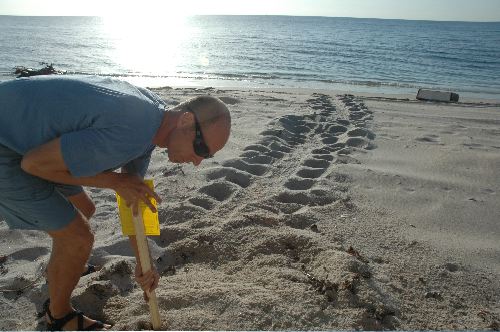 Rob is staking this Loggerhead sea turtle nest. Looking carefully at the tracks you can see which way the turtle is going.
Rob is staking this Loggerhead sea turtle nest. Looking carefully at the tracks you can see which way the turtle is going.
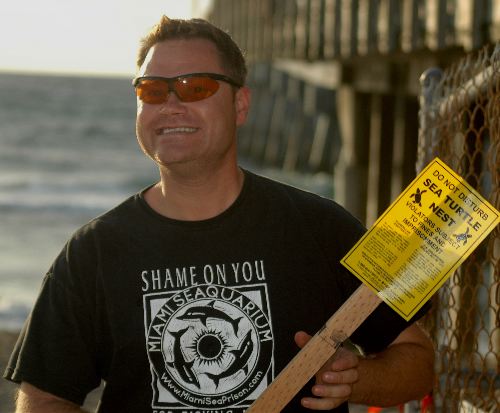 Phil lives in Lantana, Florida and has been tracking turtles for 7 years!
Phil lives in Lantana, Florida and has been tracking turtles for 7 years!
Our friend Phil Stone of Lantana **is a **Sea Turtle Monitor. He holds a permit to monitor nests on Lake Worth Beach and in Manalapan. Rob, my husband and I are trained volunteers listed on Phil’s permit. When we are in town, we monitor Lake Worth Beach. It’s a great way to start the day!
What does this mean? We have been trained by the Environmental Resource Management team to identify and stake nests with a yellow turtle sign. We go the beach just after sunrise, record the type of turtle and the date we found the nest. Then we mark through the tracks so that we don’t get confused on the next day.
It is fun. It requires investigation skills. You can tell, what kind of turtle it is, which way the turtle is going, if it laid a nest, dug a body pit or just walked up – didn’t like the area and split. If they do this we call it a false crawl.
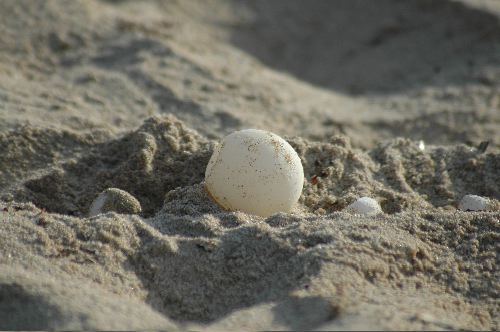 This egg was some how displaced from the nest. Not sure how, but probably some sort of predator. It is so BIG! Of course what do you expect from a 1500lb animal?
This egg was some how displaced from the nest. Not sure how, but probably some sort of predator. It is so BIG! Of course what do you expect from a 1500lb animal?
About the Nesting Turtles in Palm Beach County
We have three species that nest on our beaches **regularly, **Loggerhead ***Caretta caretta***, Green ***Chelonia mydas***, and Leatherback ***Dermochelys coriace*. **Loggerheads are the most common species and are on the Threatened Species List. Where as Green may be most abundant depending on the season, but are on the Endangered Species List as are the Leatherbacks. The great thing about the Leatherbacks is that Palm Beach County has more nests on our beaches than anywhere else in our country.
Size wise the Loggerhead is the smallest weighing only 300-400lbs and the Leatherback is huge weighing from 600-1500lbs. The Green Turtle is in the middle of these two and weighs between 400 and 600lbs. All of them eat Jellyfish! – Can you imagine getting that big off of Jellyfish! That is all the Leatherback is recorded as eating. The Loggerhead and Green Turtles also eat seaweed, algae and the Loggerhead adds crustaceans to his diet as well.
Something to think about… Jellyfish AKA Seajellies –
Think about the Portuguese Man of War – Okay technically it is** not a jelly****fish** – we will save that for another story – but this creature is a** favorite food for Turtles**. What do they and jellyfish resemble? Now think like a hungry turtle bobbing the ocean **and you see this **colored structure containing air floating and bobbing on the water– you bite and you bite and you swallow - but OH it doesn’t taste like a seajelly it was too rubbery. Then you get sick and die!
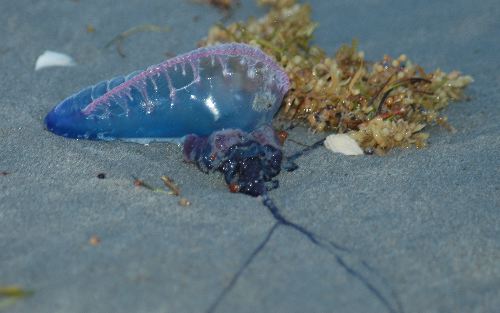 Sea Turtle Food! Hard to believe they can grow so many hundreds of pounds on these! Don't they look like balloons? Ban Balloons on the Beach!
Sea Turtle Food! Hard to believe they can grow so many hundreds of pounds on these! Don't they look like balloons? Ban Balloons on the Beach!
PLEASE, I beg you – DO NOT USE OR BRING BALLOONS ANYWHERE NEAR THE BEACH. In fact if I had my way there would be NO MORE BALLOONS – to risky for our endangered ocean critters. Blah, Bluck!
** Babies!**
Sea Turtle Nesting season **starts on **March 1 and ends October 31. This year our first nest was staked on April 22, a little **late according to Phil who has been doing this for 7 years. **
Incubation time for our sea turtles is an average of 65 days **this could range anywhere between 45 – 95 days depending on the season. Sea turtles will lay anywhere from **10-120 eggs. The babies will typically emerge at night and follow the moon to the ocean. They **swim their little hearts **out until the reach the Gulf Stream Current that is on average 4 miles from the beach. There they get into the Sargassum Weed and float the current.
This morning we noticed the most beautiful little tracks **left by many babies. **Some headed straight to the ocean and some appeared very confused, they went in circles or headed west. This is called disorientation. It could be because there was a foreign light that they were attracted to??? Some of their tracks just end before reaching the beach. What could this mean?
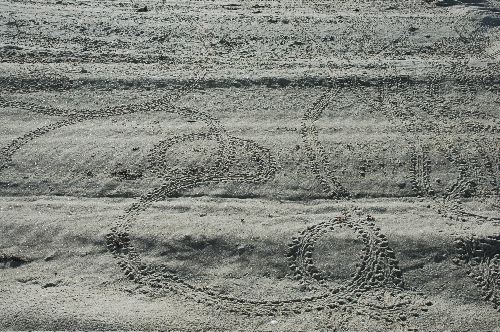 Baby Loggerhead sea turtle tracks tell us which they went. It looks like a few of them became disorientated and made some loops before heading to the ocean - or perhaps they are the sand artists of the family.
Baby Loggerhead sea turtle tracks tell us which they went. It looks like a few of them became disorientated and made some loops before heading to the ocean - or perhaps they are the sand artists of the family.
THERE ARE **478 STAKED NESTS **TO DATE, in our area – Lake Worth Beach and Manalapan!
What should you do if you see a sea turtle nesting, a marked nest or babies emerging? Look from a distance! **Be respectful. NO Flash photography**. Please don’t approach them – the heck with PLEASE – if you mess with sea turtles you can be fined up to $25,000 they are protected!
For more info check out this great website. http://www.cccturtle.org/sea-turtle-information.php?page=behavior
Bird of the Week
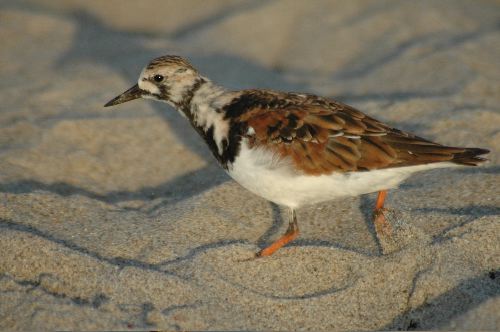 This has to be my favorite shore bird. I see them every day that I monitor sea turtle nests.
This has to be my favorite shore bird. I see them every day that I monitor sea turtle nests.
From the Tropics beholding baby turtles

